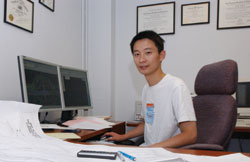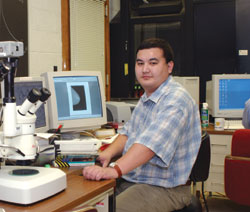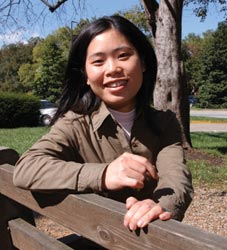![]() Current Issue
Current Issue
(Fall 2005)
Destination Speed
Grosscurth Fellows Are Among the Bright New Crop of Students Succeeding Academically at Speed
In a wired world, a student in rural China can surf the Internet, find a scholarship and end up coming to Speed School.

Wensheng Li from China , a civil engineering and environmental doctoral student and Grosscurth Fellow, is using computer models to study how to reduce highway noise.
That's what Wensheng Li did.
The 27-year-old civil engineering and environmental doctoral candidate is using computer models to study how to reduce highway noise, under the supervision of CEE professor Louis Cohn.
"Transportation is a growing concern in China," Li says. "Coming here gives me the opportunity to study and work in this field."
Li is from the eastern Chinese province of Anhui. He was attending Southeast University in the province of Jiangsu when he found out about Speed School.
After sifting through online information from 10 American universities, Li's eye was caught by the Grosscurth Fellows program, which pays the expenses of academically qualified Speed Ph.D. students.
The fellowship is one of several programs at U of L supported by a $12.5 million bequest made in 2002 by the estate of Charles and Theresa Grosscurth. The gift is the largest from an individual to U of L.
"I come from a farming area, and my family could not afford for me to go to America for study, so I am very grateful that Speed and the Grosscurth family have made these kinds of fellowships available," Li says.
The Grosscurth Fellows program represents several academic growth trends at Speed School, says Dean Thomas Hanley.
"The Grosscurth Fellows are already a success story after just one year in existence," Hanley says. "And they show how much our school is growing academically. We're getting close to our enrollment goals, graduate student enrollment is way up, we have a new mentoring program helping freshmen and upperclassmen, we have new facilities for graduate students, we've had three new Ph.D. programs approved and we're adding endowed chairs.
"I don't think a lot of people realize how comprehensive our school has become," he adds.
Hanley says graduate student enrollment has grown by about 100 students in recent years. For fiscal year 2002–2003, Speed's graduate enrollment was 617. (For information on recent Speed School successes, see the story on Thomas Hanley's legacy.)
"We've been recruiting more students from out of state, especially grad students, to enroll the best of the best," Hanley says. "Speed School has become a first destination, not just a second."
From Russia With Talent
Anuar Konkashbaev agrees that Speed is a desirable academic destination.

Grosscurth Fellow Anuar Konkashbaev came from Moscow to work and study in America. At Speed he has improved computer imaging techniques to analyze mammograms and is using computer vision in geography and geosciences to analyze minerals in ways that could help predict earthquakes.
After receiving a master's degree from the Moscow Institute for Physics and Technology in 2001, he left Russia to work at the prestigious Argonne National Laboratory near Chicago. While working in radiation and heat transport computation, Konkashbaev decided to further his studies at Speed.
"My boss at Argonne told me to look into Speed," he says. "I liked what Dr. Adel Elmaghraby was doing with medical imaging and decided to come."
Konkashbaev was one of the first students to receive a Grosscurth fellowship. He conducted research to detect breast cancer with mammogram images under the supervision of Elmaghraby, chair of the computer engineering and computer science department.
By manipulating information in a mammogram image on a computer, Konkashbaev could remove visual "noise" to zero in on a tumor, determine its actual size and see how far and deeply it had spread.
His findings were published in a paper and presented at a biomedical conference.
"This research should help doctors when they look for cancer," Konkashbaev says.
Although he is still a CECS student, Konkashbaev is now using his imaging skills in the geography and geosciences department in U of L's College of Arts and Sciences to study patterns in rocks and minerals that some day might help scientists develop ways to predict earthquakes. The study is funded by the National Science Foundation. His co-researcher is geography and geosciences department professor Jafar Hadizadeh.
More Than Academics
Like Wensheng Li, 26-year-old Li Jia received her master's degree in China before learning about Speed.

Li Jia from China of is one of many bright international students at Speed whose education is supported by the Grosscurth Fellows program. She studies infrastructure systems and how they react during failures such as the recent power outage in the Northeast.
Under the supervision of civil engineering associate professor Terence Weigel, Jia is studying infrastructure systems and how they react in disasters such as power outages and earthquakes.
Jia's family background helped influence her study interests.
In Changsha , the capital city of Hunan province, Jia's father is a planner for a housing development company.
Jia says CEE chair Mark French told her about the Grosscurth fellowship when she inquired about Speed School.
"All of my family was excited when we found out I would come here," she says. "But we were also worried because this was my first chance to go to such a distant place to study. But when I got here, everything was fine and everyone was so helpful and friendly."
Although she and her Grosscurth Fellow colleagues work hard, Jia says she is learning more than academics.
"Being in another country helps you to be familiar with other customs and meet different people," she says. "I'm learning how to live independently, and it's a great experience for me."